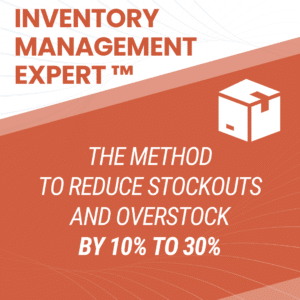Supply Chain Lead Time is a key topic in supply chain and logistics: lead time. It’s everywhere, yet measuring and optimizing lead time can be complex.
Why is it important to revisit this topic?
Global logistics concerns such as container prices, shortages, pandemics, and the lack of truck drivers have made it even more difficult. The consequences are manifold: stress for the teams, shortages for customers, overstocking, and above all, significant additional costs. This article will explain how to measure, stabilize and reduce lead times.
Before we start, don’t forget to download the free lead time calculation tool HERE:

What is lead time in Supply Chain?
Lead time: definition
Lead time in supply chain is the time that elapses between a customer order and the receipt, whether between two companies (B2B) or between a company and an end consumer (B2C). Lead time is present at all supply chain stages, from the supplier extracting the raw materials to the delivery to the end customer.
Let’s go over the jargon used to talk about lead time:
- Upstream lead times: these are the lead times that refer to all the activities required to produce and deliver raw materials, components, and finished goods to the factory or warehouse.
- Downstream lead times: refer to all the activities needed to transport the finished products from the factory or warehouse to the end customer.
- Total lead time: is simply the sum of all upstream and downstream lead times.

Total lead time under the microscope
From the moment a product is ordered (A) to the moment it is received (Z), all the time that has elapsed between the two is the total lead time. And this lead time is composed of several stages.

- 1 – The review period is when you wait before placing an order. You probably don’t place an order every day. You may even have a set day for this, so this time should be considered in the total lead time.
- 2 – The IT confirmation time is the time taken to confirm the order (considering the time the computer system takes). Some systems can take their time…
- 3 – Production times must be considered, whether you produce your products yourself or not. There are 4 types of production: MTS (Made-To-Stock): the finished products are in the warehouse, ready to be delivered. This is the fastest method but requires the most stock.ATO (Assemble-To-Order): the semifinished products will be assembled before delivery. MTO (Make-To-Order): products are manufactured to order. MTO requires a waiting period for manufacturing, assembly, picking and packing, order preparation and packaging, and waiting before shipping. ETO (Engineer-To-Order): products are created from scratch to order (rarer).
- 4 – Transport is the most obvious part of the lead time. Where does your product come from? Is it going to be transported by ship or plane? Will you have to take into account any customs delays?
- 5 – Once your product has been transported, it is placed in a warehouse… and there are many delays in a warehouse! Receiving, picking, packing, preparing the order, and waiting for the carrier are all steps to be added to your total delay.
- 6 – Finally, the last stage is local delivery to the place in question.
As you will have understood, the total lead time is far from including only the transport of the product. It is made up of all the steps mentioned above, and each must be taken into account if you want to measure and improve your lead time accurately.
Why is measuring lead time important?
Measuring lead time is essential for several reasons. Firstly, it helps to have a profitable supply chain by improving service, reducing costs, and reducing inventory. Poor lead times can lead to poor visibility, overstocking, stock-outs, and additional costs for express deliveries to compensate for problems.
Secondly, it is important to measure lead times to have good visibility on your logistics, especially in times of global crises, pandemics, or increases in container prices and transport costs. This allows you to manage your transport better lead times and ensure good customer service.
Finally, measuring lead times allows you to detect classic errors. There are 8 main ones:

Too many companies do not measure their lead times, which is the number one mistake! It is also important not to focus only on transport because not everything is about transport. Think about intermediate lead times and stabilize them before reducing them for a more efficient management of your supply chain.
How to measure logistics lead time effectively in Excel?
Before we start, don’t forget to download the free lead time calculation tool HERE:

Calculate the average logistics lead time
In this Excel template, you will find an example of 10 orders. You will notice a supplier in China and a customer in the USA. The 3rd column has the order dates (we see that the orders are made on the 1st of each month). Then we look at the quantities ordered in column 4 and the value of the order in $ in column 5.

The first important piece of information is in column 6, the so-called Contract Delivery Date, in other words, the contractual delivery date dictated by your supplier. In this case, the contractual delivery date is 30 days, which has been added to the order date.
Column 7 is the measure of the Real Delivery Date. Column 8 contains the Contract Lead Time, which we have already mentioned (here, it is 30 days by default). What will help us measure the Real Lead Time is the difference between the real delivery date and the order date.
Let’s now look at column 11, the Delay. This will tell you if your delay is equal to the delay expected by your supplier (30 days in this case) or not.
- Our first order, Order 1, shows us a delay of 0 with a lead time of exactly 30 days, right on time!
- For Order 2, on the other hand, we observe a delay. To calculate this, it’s simple: you calculate the Real Delivery Time minus the Contract Lead Time (in this case, 40 days, i.e., 10 days more than the promised 30 days).
- And so on! The color codes help you understand your lead times at a glance.
Once you have entered your orders into this tool, look at the average on the last line. In this example, the average delivery time is 37.4 days, whereas the contractual delivery time was 30 days. This difference is more than 7.4 days, which is very important in percentage terms!
Graphical view of the logistics lead time
Thanks to this logistic lead time tool, you will have a graphical view of your lead time.

- The red line represents your Contact Lead Time, i.e., the contractual lead time with your supplier.
- The green line represents your Real Lead Time: you see your orders and their arrival dates.
- The yellow line represents your Average Lead Time, calculated by averaging the Real Lead Time data (green line).
So what do we see in this graph? There is a frequent delay.
Then, you should put 37 days and not 30 days in your system / ERP if you don’t want to miscalculate inventory replenishment values.
You can therefore question the supplier by explaining that you had a contractual lead time of 30 days and that your current average is 37 days. This can be the subject of negotiation to obtain penalties, compensation, or bonuses to improve the situation.
How to interpret this data?
It is crucial to update your lead times in the system, especially if you have a mini-max, safety stock, or reorder point in place. I notice that many companies don’t do this, which is a big mistake. By adjusting your lead times, you can better manage shortages and overstock, which will greatly improve the accuracy of your stock management.
However, you should not stop there. It is also important to analyze the differences between each order’s contractual lead times and actual delivery times. This will allow you to understand the reasons for these discrepancies and to take steps to reduce them in the future.
This tool also allows you to evaluate the performance of each supplier based on these variances and make decisions to improve your supply chain.
It is also important to monitor the stability of your supply chain. If your actual delivery times vary considerably from order to order, this may be a sign of a deeper problem. You can use statistical tools to assess the stability of your supply chain and take steps to make it more stable.
Finally, remember that stock management is not just about managing delivery times. Think about managing your stock levels to avoid overstock and shortages. You can use demand forecasting tools to predict how much product you will need in the future, which will help you plan your purchases and avoid overstocking or shortages.
Don’t overlook outliers
Don’t overlook outliers when analyzing data in Excel.
Imagine a problem with an order that results in a 200-day lead time. Including this data in your calculation would increase your average lead time without it being the case.
A single extreme value can distort the average results and lead to miscalculations in the supply forecast. I recommend manually or automatically cleaning up extreme values to avoid these errors. Don’t just focus on averages, but consider the stability of the data for effective safety stock management.
Focus on the stability of lead times
Don’t just focus on average lead times. Focusing only on average lead times may not give you a more critical overview of your situation. Take this example:

On the left is a situation with an average lead time of 37.4 days; on the right, an average lead time of 37.5 days. The averages look really similar, and yet, if you look at the graph, the situation on the right is much more stable and easier to manage. With this stability, you can reduce your safety stock and thus reduce the money you invest.
To find out how to calculate the safety stock, use one of these 6 formulas.
Think about the degree of uncertainty
I advise you to rank suppliers or lead times according to their level of uncertainty and stability in order to manage stock levels appropriately and optimize service and profit for the business. Use dynamic safety stocks for better risk management.

Finally, don’t make the mistake of trying to reduce lead times before stabilizing them. Instead, there are three key steps: measure, stabilize, and reduce lead times. Doing so makes it possible to optimize financial ratios and customer satisfaction by delivering products on time.
Lead Time: Action Plan
Here are some points to consider to measure and improve your lead times effectively:
- Measure intermediate lead times
- Regularly update lead times in ERP systems
- Make manual readings to check computer data
- Identify and eliminate extreme values
- Stabilise lead times before trying to reduce them
- Involve suppliers in optimizing lead times
Also find out about one of my other blog posts: Forecast Accuracy formula: 4 Calculations in Excel






